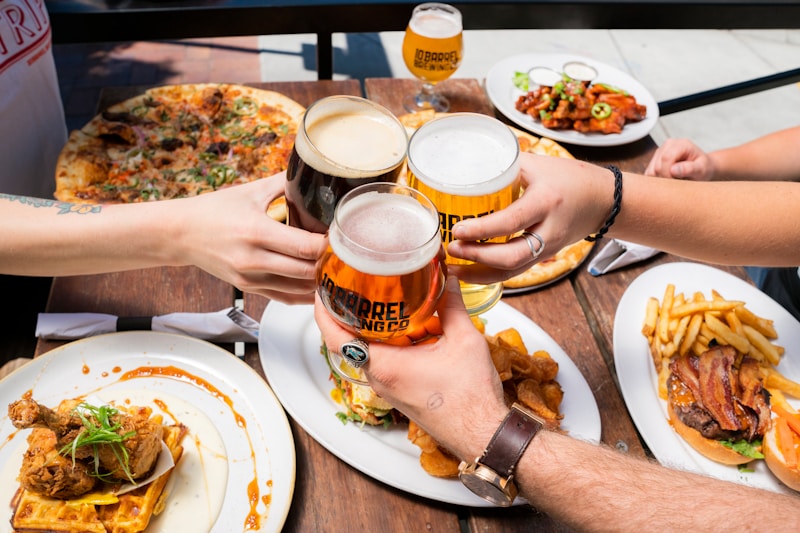32 Questions
What characteristics can help reveal both the type/brand and the condition of beer?
Colour, clarity, and foam
How is the colour of a beer best determined?
Using a powerful flashlight
What are the descriptors used to indicate the colour of beer?
Pale straw, straw, pale gold, deep gold
What does clarity depend on in beer?
Filtration, sedimentation, and age
What term is used for beers that are not completely bright?
Opaque
What can be deduced from the characteristics of colour, clarity, and foam in beer?
Type/brand and condition of the beer
What is the term for the haze that may appear in allmalt beers when served very cold?
Chill haze
What causes bubbles to rise rapidly from specific points at the bottom of a glass?
Imperfections in the bottom of the glass (nucleation sites)
What is the range of colours for foam, or 'head', in beers?
Snow-white to light beige
Which aspect of beer tasting involves the interplay between mouth and nose?
Aroma perception
What are the five primary flavours that taste buds on the tongue can sense?
Sweet, salty, sour, bitter, 'umami'
What is the characteristic of nucleation sites in beer glasses?
Deliberately created by scratching the bottom of the glass with a laser
What is the primary effect of glutamate in food and drinks?
'Umami' flavor enhancement
What influences the ability to taste beer according to the text?
Conditions that influence our ability to taste
What type of beers may become cloudy when served very cold?
'Allmalt' beers
What is the term for the appearance of relatively large bubbles in different locations combined with a coarse head in glasses?
Glasses not 'beer clean'
What is the numerical classification used to indicate the bitterness of most beers?
BU (Bitterness Units)
Which mouthfeel sensation can be detected by the tongue and can vary enormously per beer type?
The carbonation level
What is the relationship between sensory bitterness and the BU-value for beers described as 'Moderately bitter'?
20 - 30 BU
What is the questionable aspect regarding the human palette's ability to detect bitterness differences?
Detecting differences above 65 BU’s
What is the term used to express the degree of bitterness for most beers?
BU’s (Bitterness Units)
What type of beers have brewers started competing to brew with more and more bitterness, some with BU values above 90?
All types of beers
Which of the following sensations can a beer with a lot of residual sugar be compared to?
A sandwich in your mouth
What type of beer can leave your teeth feeling rough?
Sour beer
What is the primary effect of high alcohol content in beer?
Creating a warming feeling in the mouth and pharynx
What can a soapy taste in beer indicate?
Low acidity
What does a metal taste in beer leave in the mouth?
A coin or blood-like sensation
How can tannins in beer be described in terms of mouthfeel?
Rough and astringent feeling
Which method divides the tasting into appearance, flavour, body, mouthfeel, carbonation, and aftertaste?
Structured process tasting
What is the main objective of discriminative tasting?
Discovering different beers
In appreciative tasting, which aspect are jury members evaluating beers based on?
'Pre-determined style guidelines'
What is the purpose of using tasting forms during the evaluation process?
To guide tasters through the evaluation process
Study Notes
Characteristics of Beer
- The characteristics of colour, clarity, and foam can reveal the type/brand and condition of beer.
- Colour is best determined by holding the beer at an angle against a white background.
- Descriptors used to indicate the colour of beer include SRM (Standard Reference Method), EBC (European Brewing Convention), and degrees Lovibond.
- Clarity depends on the presence or absence of suspended particles, such as yeast or proteins.
- Beers that are not completely bright are referred to as "hazy" or "cloudy".
Foam and Bubbles
- The term "chill haze" is used to describe the haze that may appear in all-malt beers when served very cold.
- Nucleation sites in beer glasses, such as imperfections or scratches, cause bubbles to rise rapidly from specific points at the bottom of a glass.
- The range of colours for foam, or "head", in beers is from pure white to dark cream.
Taste and Mouthfeel
- The interplay between mouth and nose involves the aspect of beer tasting known as "flavour".
- The five primary flavours that taste buds on the tongue can sense are sweet, sour, salty, bitter, and umami.
- Glutamate is an amino acid that enhances the umami flavour in food and drinks.
- The ability to taste beer is influenced by the sensitivity of the individual's taste buds.
- Beers that may become cloudy when served very cold are those that contain high levels of protein or starch.
Bitterness and Sensory Perception
- The numerical classification used to indicate the bitterness of most beers is the International Bitterness Unit (IBU) scale.
- The primary effect of bitterness in beer is described as a dry, puckering sensation.
- Sensory bitterness and the BU-value (Bitterness Unit) are directly related for beers described as "Moderately bitter".
- The human palate's ability to detect bitterness differences is questionable, as it can vary greatly between individuals.
- The term used to express the degree of bitterness for most beers is IBU (International Bitterness Unit).
Beer Styles and Characteristics
- Brewers have started competing to brew beers with more and more bitterness, some with BU values above 90, known as "Double" or "Triple" IPAs.
- Beers with a lot of residual sugar can be compared to a sweet, syrupy sensation.
- Beers that can leave your teeth feeling rough are those with high levels of tannins.
- The primary effect of high alcohol content in beer is a warming sensation.
- A soapy taste in beer can indicate contamination with sanitizers or cleaning agents.
- A metal taste in beer leaves a bitter, unpleasant sensation in the mouth.
Tasting and Evaluation
- Tannins in beer can be described in terms of mouthfeel as a drying, astringent sensation.
- The method that divides the tasting into appearance, flavour, body, mouthfeel, carbonation, and aftertaste is the "BJCP" (Beer Judge Certification Program) method.
- The main objective of discriminative tasting is to identify and describe the characteristics of a beer.
- In appreciative tasting, jury members evaluate beers based on their overall quality and character.
- The purpose of using tasting forms during the evaluation process is to provide a standardized and structured way to record and assess the characteristics of a beer.
Test your knowledge on the appearance tasting aspect of beer. Learn about how characteristics like color, clarity, and foam can reveal the type, condition, age, carbon dioxide amount, and quality of a beer.
Make Your Own Quizzes and Flashcards
Convert your notes into interactive study material.



